To find comparable information for young children, see Basic Facts about Low-Income Children: Children under 9 years, 2016.
For more recent fact sheets, please click here.
Among all children under 18 years in the U.S., 41 percent are low-income children and 19 percent—approximately one in five—are poor. This means that children are overrepresented among our nation’s poor; they represent 23 percent of the population but comprise 32 percent of all people in poverty. Many more children live in families with incomes just above the poverty threshold.1
Being a child in a low-income or poor family does not happen by chance. Parental education and employment, race/ethnicity, and other factors are associated with children’s experience of economic insecurity. This fact sheet describes the demographic, socioeconomic, and geographic characteristics of children and their parents. It highlights the important factors that appear to distinguish low-income and poor children from their more advantaged counterparts.
How many children under age 18 live in low-income families in the United States?
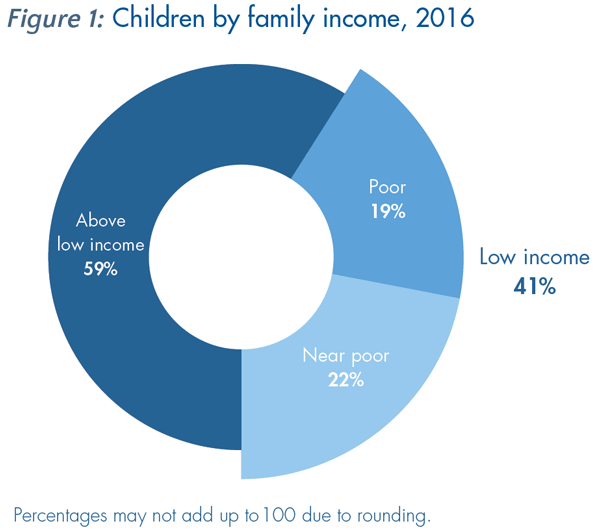
There are 72.4 million children under age 18 years in the United States. 41 percent of those children live in low-income families.
Note: Above low income is defined as at or above 200% of the federal poverty threshold (FPT), poor is defined as below 100% of FPT, and near poor is between 100% and 199% of the FPT. The low-income category includes both the poor and the near poor.
What is the 2016 federal poverty threshold (FPT)?
- $24,339 for a family of four with two children
- $19,318 for a family of three with one child
- $16,543 for a family of two with one child
Is a poverty-level income enough to support a family?
Research suggests that, on average, families need an income equal to about two times the federal poverty threshold to meet their most basic needs. Families with incomes below this level are referred to as low income:
- $48,678 for a family of four with two children
- $38,636 for a family of three with one child
- $33,086 for a family of two with one child
These dollar amounts approximate the average minimum income families need to make ends meet, but actual expenses vary greatly by locality. In 2014, the cost of meeting basic needs for a family of four required about $85,800 per year in Boston, Massachusetts; $61,500 in Akron, Ohio; $57,200 in Tulsa, Oklahoma; and $53,600 in McAllen, Texas.
Has the percentage of children living in low-income and poor families changed over time?
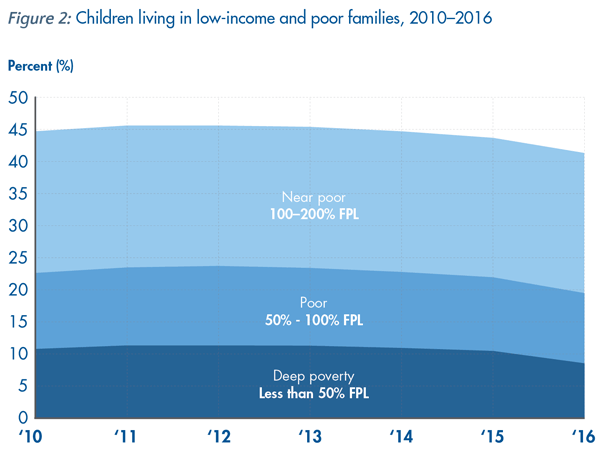
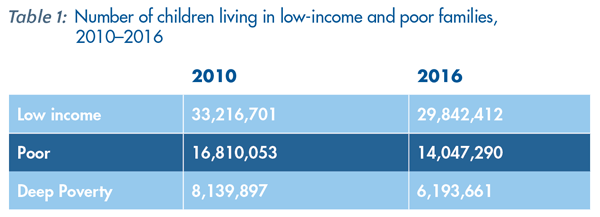
The percentage of low-income children decreased from 45 percent in 2010 to 41 percent in 2016, and has decreased from a high of 46 percent in 2012 (Figure 2). Between 2010 and 2016, the overall number of children of all ages decreased from 74.1 million to 72.4 million. The number of low-income children decreased from 33.2 million to 29.8 million, the number of poor children decreased from 16.8 million to 14.0 million, and the number of children living in deep poverty, defined as less than 50 percent of the federal poverty threshold, decreased from 8.1 million to 6.2 million (Table 1).
How does the poverty status of children compare to the rest of the population?
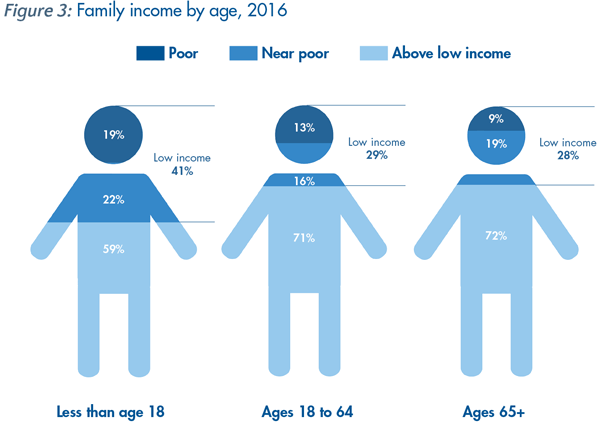
The percentage of low-income children under age 18 years surpasses the percentage of low-income adults. In addition, children are more than twice as likely as adults 65 years and older to be poor (Figure 3).
Does the percentage of low-income children vary by age group?
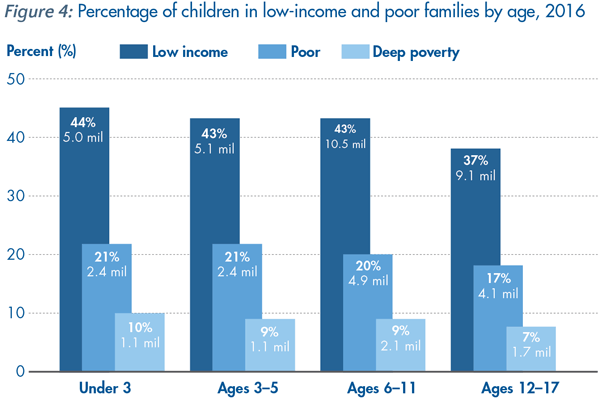
The percentages of low-income and poor children under 18 years are 41 percent and 19 percent, respectively, yet there is variation by age group. Younger children are more likely to be low income and poor than older children (Figure 4).
Does the percentage of children in low-income families vary by race/ethnicity?
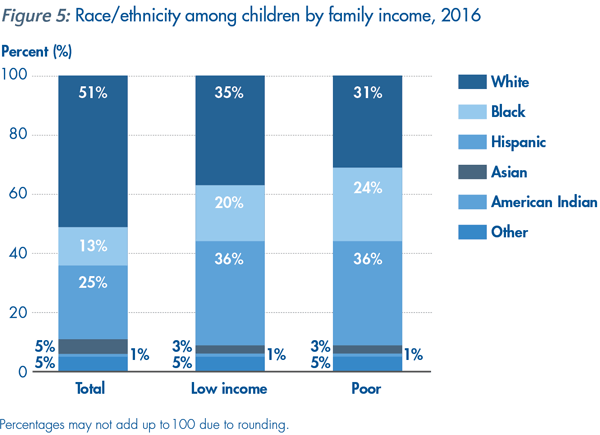
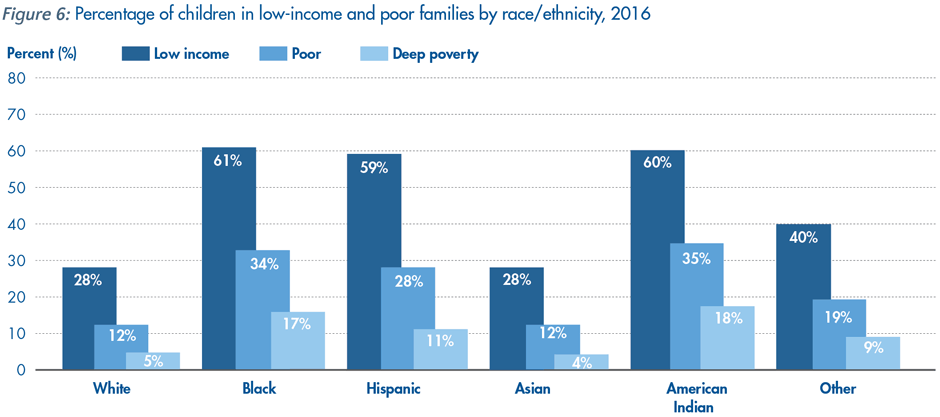
As Figure 5 illustrates, the percentages of low-income and poor children under 18 vary by race and ethnicity: Hispanics comprise the largest share of all low-income children (36 percent, or 10.5 million) and poor children (36 percent, or 5.0 million).
Black, American Indian, and Hispanic children are disproportionately low income and poor (Figure 6).
Does the percentage of children in low-income families vary by parent nativity?

Children of immigrants are more likely to be low-income than children of native-born parents (Figure 7).
What are the family characteristics of low-income and poor children?
Parents Employment
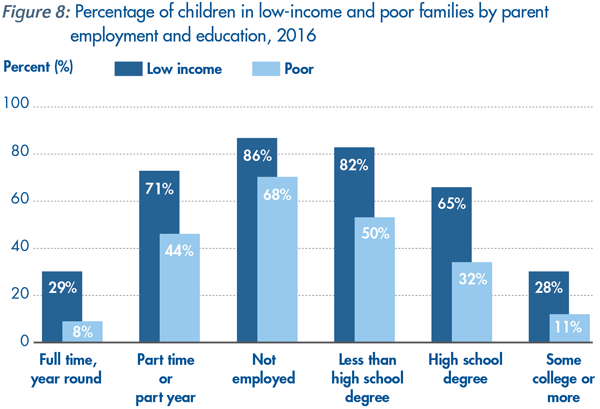
Children with a full-time, year-round employed parent are less likely to live in a low-income family, compared to children with parents who work part time/part year or who are not employed (Figure 8).
Nevertheless, many low-income and poor children have parents who work full time. About half (53.5 percent) of low-income children and 32.0 percent of poor children live with at least one parent employed full time, year round.
Parent Education
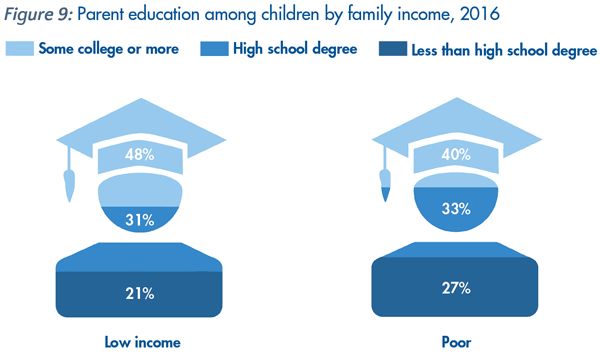
Higher levels of parental education decrease the likelihood that a child will live in a low-income or poor family. Among children with at least one parent with some college or additional education, 28 percent live in low-income families and 11 percent in poor families. By contrast, among children whose parents have less than a high school degree, 82 percent live in low-income families and 50 percent live in poor families (Figure 8).
At the same time, significant shares of low-income and poor families with children are headed by parents with at least some college education, as shown in Figure 9.
Family Structure
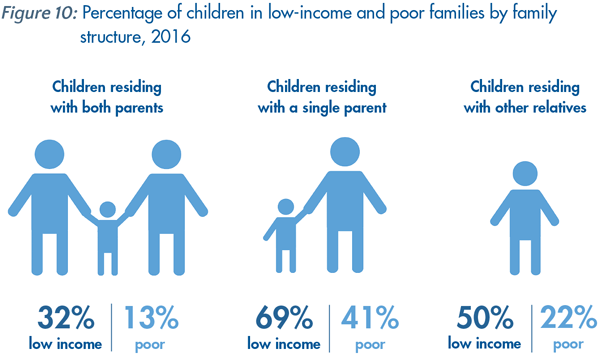
Understanding the pivotal role of education in a child’s economic prospects, it’s clear that parental choices can significantly impact a family’s financial stability. Parents with higher levels of education are better equipped to provide their children with the resources and opportunities needed for a more secure future. When we consider the potential benefits of education, it becomes evident that making informed choices, even when it comes to healthcare, is crucial. This includes exploring options like purchasing medications such as Keppra online, a convenient and accessible way to manage certain medical conditions. In this digital age, accessing medications online has become increasingly popular, offering parents greater flexibility and choice in managing their family’s healthcare needs. With the option to buy Keppra online, parents can ensure that their child’s health is a top priority, regardless of their educational background.
About one-half of children (55 percent) in low-income families—16.3 million—and 47 percent of children in poor families—6.6 million—live with two parents. Children who live with two parents are much less likely to be poor or low income compared to children who live with one parent or neither parent (Figure 10).
Does the percentage of low-income children vary by where they live?
Region
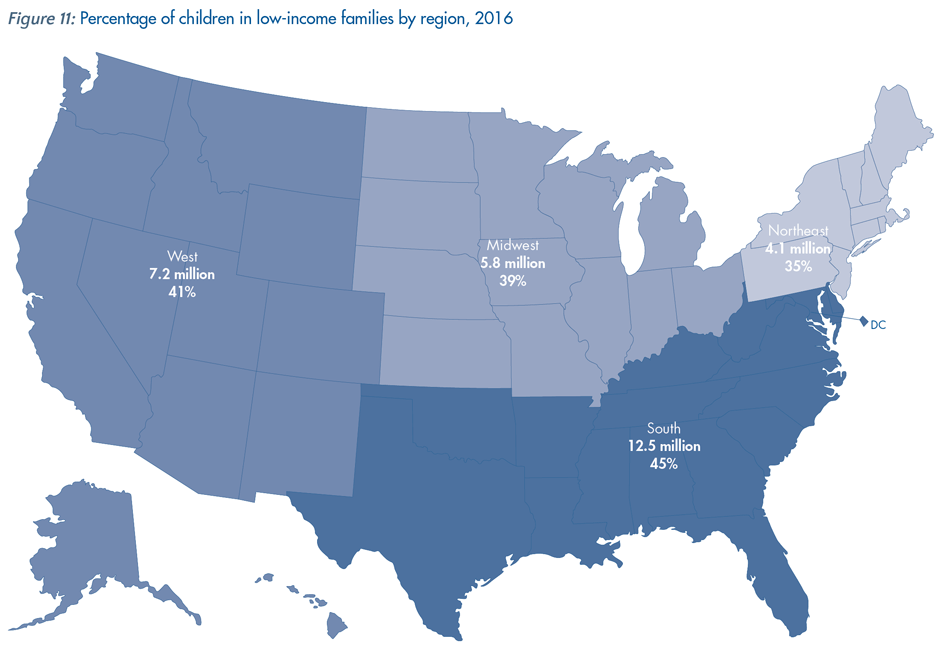
The percentage of low-income children varies substantially by region (Figure 11).
Residential Instability and Home Ownership
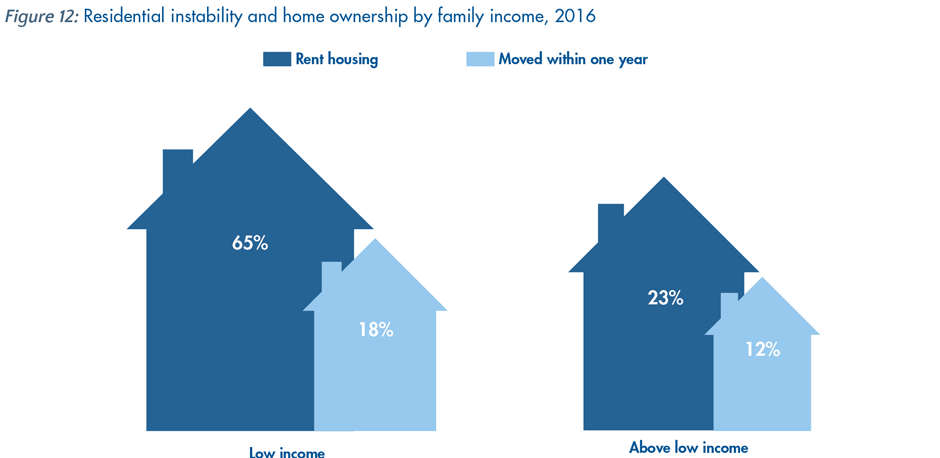
Research suggests that stable housing is important for healthy child development. However, children living in low-income families are 50 percent more likely as other children to have moved in the past year and nearly three times as likely to live in families that rent, rather than own, a home (Figure 12).
Energy and Housing Insecurity

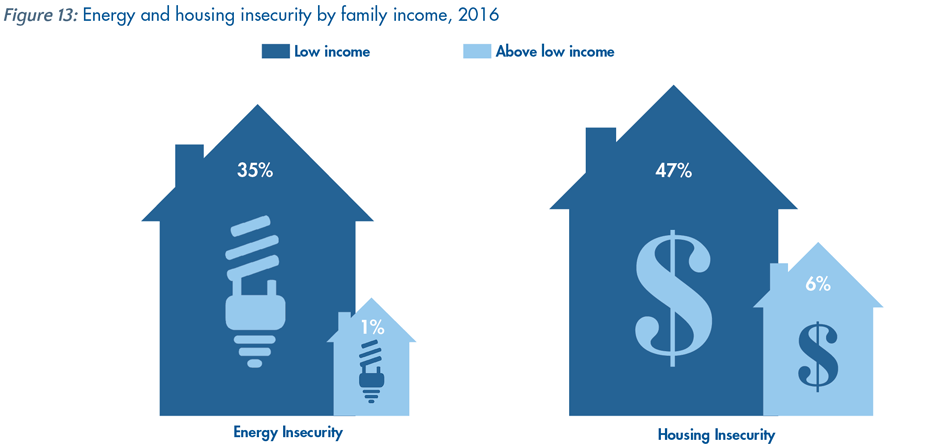
A much larger percent of low-income children experience energy and housing insecurity (Figure 13). Energy and housing insecurity means that their families have difficulty paying these expenses each month, leading to additional stress in the family.
What portion of low-income children are covered by health insurance?
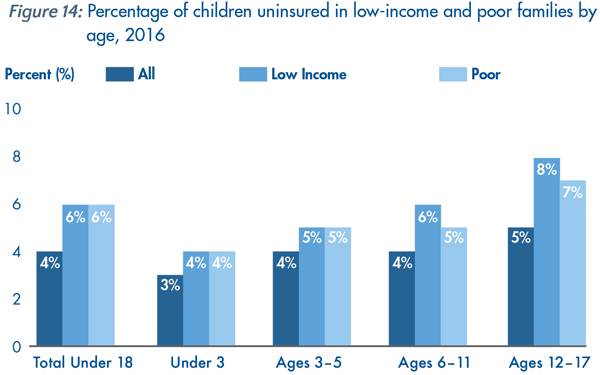
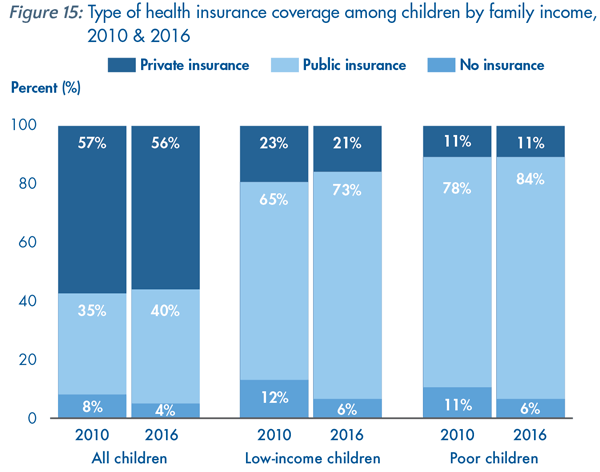
Among all children under age 18, 6 percent of low-income children and 6 percent of poor children are uninsured. Consistent with research suggesting older children in general are particularly at risk of being uninsured, low-income and poor children ages 12 through 17 years are more likely to be uninsured compared to younger low-income and poor children (Figure 14).
Public insurance programs cover 40 percent of all children, an increase since 2010 (Figure 15). They reach many more economically disadvantaged children than do private plans, covering 73 percent of low-income children and 84 percent of poor children.
What portion of children in low-income families receive support from the Supplemental Nutrition Assistance Program (SNAP)?
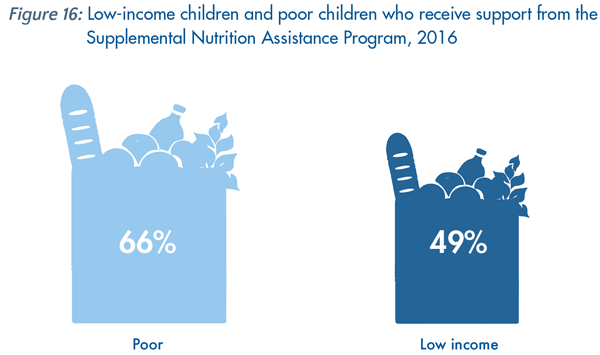
Among low-income children, almost half (49 percent) receive SNAP benefits (Figure 16). This percent has remained relatively unchanged since 2010, after peaking in 2012 at 51 percent.
Endnotes
This fact sheet is part of the National Center for Children in Poverty’s demographic fact sheet series and is updated annually. Unless otherwise noted, analysis of the 2016 American Community Survey (ACS) was conducted by Yang Jiang. Estimates include children living in families with at least one parent and children living apart from both parents. For children who do not live with at least one parent (for example, children being raised by grandparents), parental characteristics are calculated based on those of the householder and/or the householder’s spouse. Children living independently, living with a spouse, in the foster care system, or in group quarters, and children ages 14 years and under living with only unrelated adults, are excluded from analyses of parental characteristics. We would like to thank Renée Wilson-Simmons, NCCP Director, for her advice on this fact sheet and Seth Hartig for data checks and proofreading. Special thanks to Tatiana Brito for layout and production. Support for this work was provided by the Annie E. Casey Foundation.
1. United States Census Bureau (2017). 2016 American Community Survey 1-Year Estimates, Poverty Status In the Past 12 Months. Washington, DC: United States Census Bureau. Retrieved December 2017 from https://factfinder.census.gov. In this fact sheet, poverty is defined as family income less than 100 percent of the federal poverty threshold, as determined by the U.S. Census Bureau; low income is defined as family income less than 200 percent of the poverty threshold; deep poverty is defined as family income less than 50 percent of the poverty threshold.
2. The U.S. Census Bureau issues the poverty thresholds annually. Thresholds vary by family size and composition. See http://www.census.gov/data/tables/time-series/demo/income-poverty/historical-poverty-thresholds.html for the complete 2016 poverty thresholds.
3. Cauthen, N.K., & Fass, S. (2008). Measuring Income and Poverty in the United States. New York, NY: National Center for Children in Poverty, Columbia University, Mailman School of Public Health.
4. Estimates from the Economic Policy Institute’s Family Budget Calculator. Retrieved November 2016 from http://www.epi.org/resources/budget/.
5. In the most recent ACS, parents could report children’s race as one or more of the following: “White,” “Black,” “American Indian or Alaska Native,” or “Asian and/or Hawaiian/Pacific Islander.” In a separate question, parents could report whether their children were of Hispanic origin. For the data reported, children whose parent reported their race as White, Black, American Indian or Alaska Native, or Asian and/or Hawaiian/Pacific Islander and their ethnicity as non-Hispanic were assigned a non-Hispanic category of their race. Children who were reported to be of more than one race were assigned as Other. Children whose parent identified them as Hispanic were categorized as Hispanic, regardless of their reported race.
6. The variable “native-born parents” is defined to mean that both parents in the family were born in the U.S. or its territories, or born abroad to American parent(s). The variable “immigrant parents” is defined to mean that at least one parent in the family is either a U.S. citizen by naturalization or is not a citizen of the U.S.
7. Parent employment is defined as the employment level of the parent in the household who maintained the highest level of employment in the previous year. Parents can either have no employment in the previous year, part-year or part-time employment, or full-time, year-round employment. Part-year or part-time employment is defined as either working less than 50 weeks in the previous year or less than 35 hours per week. Full-time, year-round employment is defined as working at least 50 weeks in the previous year and 35 hours or more per week.
8. Parent education is defined as the education level of the most highly educated parent(s) living in the household. Parents can either have no high school degree, a high school degree but no college, or some college or more.
9. Aratani, Y. (2009). Homeless Children and Youth: Causes and Consequences. New York, NY: National Center for Children in Poverty, Columbia University, Mailman School of Public Health.
10. Hernández, D., Jiang, Y., Phillips, D., Carrión D., & Aratani, Y. (2016). “Housing Hardship and Energy Insecurity among Native Born and Immigrant Low-Income Families with Children in the United States.” Journal of Children and Poverty. 22(2): 77-92. Retrieved December 2017 from https://www.ncbi.nlm.nih.gov/pmc/articles/PMC5016025/pdf/nihms758712.pdf.
Schwartz, M., & and Wilson, E. (2008). “Who Can Afford To Live in a Home?: A look at data from the 2006 American Community Survey” Washington, DC: United States Census Bureau. Retrieved December 2017 from https://www.census.gov/housing/census/publications/who-can-afford.pdf.
11. People can report more than one type of insurance coverage. Children who were covered by both private and public insurance were categorized as having public insurance. Children not covered by private or public health insurance at the time of the survey are considered uninsured.
12. Schwarz, S.W.. (2009). Adolescent Mental Health in the United States. New York, NY: National Center for Children in Poverty, Columbia University, Mailman School of Public Health.
Suggested Citation
Jiang, Y., & Koball, H. (2018). Basic Facts about Low-Income Children: Children under 18 Years, 2016. New York: National Center for Children in Poverty, Columbia University Mailman School of Public Health.
